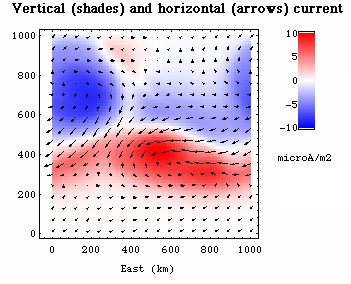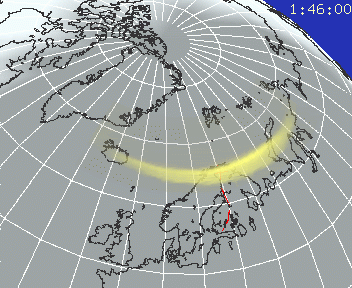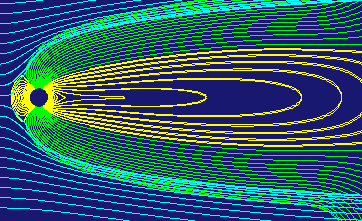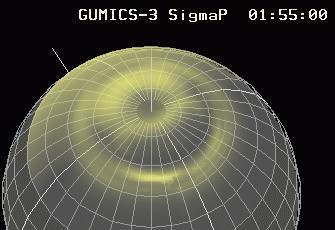Most figures download an animation when clicked
GUMICS (Grand Unified Magnetosphere-Ionosphere Coupling Simulation) grew up from two-dimensional simulations of Lotko and coworkers (J. Geophys. Res. 96, 9549-9565, 1991); although all source code in GUMICS is new.

Our first simulation of ionosphere-magnetosphere coupling (Janhunen and Huuskonen, J. Geophys. Res. 98, 9519-9350) was an extension of Lotko's and Shen's model by including spatially varying ionospheric conductivities. It was mainly used for simulating eastward drifting Omega bands using a two-dimensional model with incompressible fluid to model the magnetosphere.
 Click for QuickTime animation (870 KB)
Click for QuickTime animation (870 KB)
In the next model, which we call GUMICS-1 the magnetosphere was no longer a two-dimensional slab but a three-dimensional box. The size of the box was -20 .. -6 Earth radii in GSM X, -5..5 in Y, 0..5 in Z. (X axis is sunward, Y duskward, Z northward). North-south symmetry was assumed. We call this kind of simulation box semiglobal, because it covers the magnetospheric region which is probably the most important for substorm onset, but is not completely global. You can view the results of this work as an MPEG movie (or a higher time resolution movie of interesting period) or a QuickTime movie. Movie explanation is also available.
 Click for QuickTime animation (3.2 MB)
Click for QuickTime animation (3.2 MB)The next model (GUMICS-2) uses a hierarchical cubic grid and a locally varying timestep to achieve high computing efficiency. The model is now global. The magnetospheric simulation box is a global one. The ionospheric model is similar to the semiglobal model, except for the change of geometry.
 Click for QuickTime animation (5 MB)
Click for QuickTime animation (5 MB)
The latest model (GUMICS-3) is similar to GUMICS-2 except that the numerical method is more advanced, introducing smaller numerical diffusion. In GUMICS-2 we used the Lax method (simple finite difference (FD) method), whereas GUMICS-3 uses the finite volume method (FVM) with Godunov-type first-order accurate upwind scheme developed for the fully conservative form of MHD equations using a linearized Riemann solver.
Pekka Janhunen (First.Last@fmi.fi)